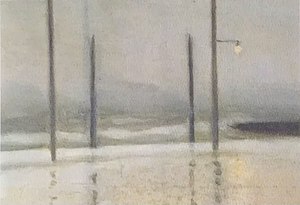
The Victorian Artists Society, which can trace its establishment to 1856 in Melbourne, promotes artistic education, art classes and gallery hire exhibition in Australia. It was formed in March 1888 when the Victorian Academy of Arts and the Australian Artists' Association amalgamated.

Tonalism was an artistic style that emerged in the 1880s when American artists began to paint landscape forms with an overall tone of colored atmosphere or mist. Between 1880 and 1915, dark, neutral hues such as gray, brown or blue, often dominated compositions by artists associated with the style. During the late 1890s, American art critics began to use the term "tonal" to describe these works, as well as the lesser-known synonyms Quietism and Intimism. Two of the leading associated painters were George Inness and James McNeill Whistler.

Duncan Max Meldrum was a Scottish-born Australian artist and art teacher, best known as the founder of Australian tonalism, a representational painting style that became popular in Melbourne during the interwar period. He also won fame for his portrait work, winning the prestigious Archibald Prize for portraiture in 1939 and 1940.

The Athenaeum or Melbourne Athenaeum at 188 Collins Street is an art and cultural hub in the central business district of Melbourne, Victoria, Australia. Founded in 1839, it is the city's oldest cultural institution.

Clarice Marjoribanks Beckett was an Australian artist and a key member of the Australian tonalist movement. Known for her subtle, misty landscapes of Melbourne and its suburbs, Beckett developed a personal style that contributed to the development of modernism in Australia. Disregarded by the art establishment during her lifetime, and largely forgotten in the decades after her death, she is now considered one of Australia's greatest artists.

George James Coates was an Australian painter, primarily dealing with portraits. He worked as an official war artist to the Australian government in 1919, and from then on specialised in war subjects until his death in 1930.
Reginald Ward Sturgess was an Australian artist.
James William Govett was an Australian impressionist who worked mostly in watercolor and oil, focusing on landscapes and portraits.

Percy Alexander Leason was an Australian political cartoonist and artist who was a major figure in the Australian tonalist movement. As a painter and commercial artist his works span two continents.
Colin Cuthbert Orr Colahan was an Australian painter and sculptor. Educated at Xavier College.

Twenty Melbourne Painters Society is an Australian arts organisation that was established in 1918. The group split from the Victorian Artists Society to follow the Australian Tonalist Max Meldrum. Membership is restricted to 20 and is upon invitation only. The society follows the traditions of realist, tonal and impressionist painting and holds an annual exhibition.

Polly Hurry, was an Australian painter. She was a founding member of the Australian Tonalist movement and part of the Twenty Melbourne Painters Society.

Estelle Mary (Jo) Sweatman (1872-1956), was an Australian painter. She was a founding member of the Twenty Melbourne Painters Society.

Henrietta Maria Gulliver was an Australian artist who specialized in landscape and floral still-life paintings. She was also a florist, horticulturalist and landscape designer.
Ruth Sutherland (1884–1948), was an Australian painter and art critic. She was a founding member of the Twenty Melbourne Painters Society.
William Frater (1890–1974) was a Scottish-born Australian stained-glass designer and modernist painter who challenged conservative tastes in Australian art.

Castlemaine Art Museum is an Australian art gallery and museum in Castlemaine, Victoria in the Shire of Mount Alexander. It was founded in 1913. It is housed in a 1931 Art Deco neo-classical building constructed for the purpose, heritage-listed by the National Trust. Its collection concentrates on Australian art and the museum houses historical artefacts and displays drawn from the district.

Arnold Joseph Victor Shore was an Australian painter, teacher and critic.
Alexander Colquhoun was a Scottish-born Australian painter, illustrator and art critic.
The Australian Academy of Art was a conservative Australian government-authorised art organisation which operated for ten years between 1937 and 1946 and staged annual exhibitions. Its demise resulted from opposition by Modernist artists, especially those associated with the Contemporary Art Society, though the influence of the Academy continued into the 1960s.


















